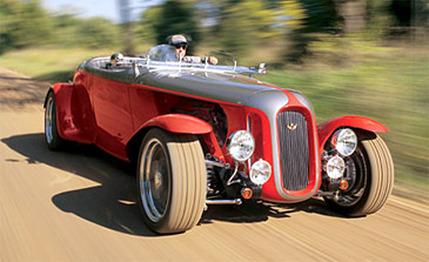
 Specialty File
Specialty File
Terminal dementia is a basic qualifier for anyone who tries to build his own car. My own affliction came when I bought the Duffy Livingstone Eliminator vintage road-racing hot rod and with the great fun involved in restoring and racing the old beast—capped by its class victory at Pebble Beach last August (C/D, December 2003 ). The mission of the new Eliminator Special was to create a car that Livingstone might have built in the 1950s had such wonderful components as a Dodge Viper V-10 engine and gearbox, Baer vented disc brakes, carbon-fiber bodywork, Corsa exhaust systems, and modern rubber been available to him.
Having access to such items, my partner, Sam Turner, and I launched our pal Barry Brown and his team of craftsmen at Riter Vintage Car Care in East Rochester, New York, to build a street rod that was an amalgam of modern technology and 50-year-old sports-car and hot-rod styling. The goal was a machine that would rival the Cobra's legendary 0-to-100 time, pull 1.00 g on the skidpad, and run 0 to 60 in less than four seconds—all the while behaving on the street like a civilized, useful road car. Our goals were surpassed in some cases, missed in others (see specs). But we consider this to be our prototype, and presuming customer interest remains at a high level, we plan to build an improved version employing a tubular chassis and a stiffer yet lighter steel body. The fun has just begun. —Brock Yates
Here's what you need to know about the Eliminator: 465 horsepower and 2640 pounds. We're talking about a power-to-weight ratio that's only 13 percent worse than that of a $650,000 Ferrari Enzo.
The biggest problem with driving the Eliminator is keeping the rear wheels from spinning. Yates was smart enough to fit it with sticky Toyo Proxes RA-1 tires that are closer to race tires than street units, but still it smokes the rears all too easily.
It did, however, keep the tires glued well enough to rip off a 3.3-second 0-to-60-mph sprint, matching the time of that Enzo. Around the skidpad, the Eliminator almost cleared the magical 1.00-g mark but fell just a tad short at 0.98 (the Enzo, 1.05). The Eliminator's immensely powerful brakes were easy to modulate and hauled it down from 70 mph in 165 feet.
Those are fantastic numbers for sure, and that kind of performance alone would thrill anyone. But the Eliminator has this kind of throwback, wind-in-your face aura that's endearingly un-PC.
Just sitting in it feels almost dangerous. In fact, you don't sit in it as much as you sit on it. The windscreen directs the breeze perfectly to the scalp line, and at more than 100 mph, the buffeting is severe enough to blur your vision. On rough roads, the Eliminator darts and weaves, demanding that the driver manhandle the thing through the oversize steering wheel.
Rough? You bet. But it faithfully continues the tradition of a crude, domestic sports car that has the balls and arrogance to flip off far more expensive rides. From Yates, I expected nothing less. —Larry Webster